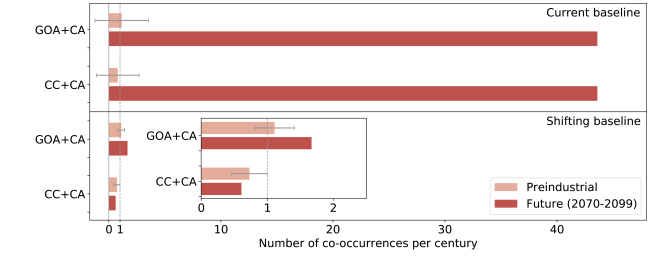Will compound marine heatwave-drought events along the West Coast become more frequent in the future?
From 2013–2016, northeast Pacific Ocean experienced an extreme marine heatwave extending from the Gulf of Alaska to Baja California, Mexico. During this time, California suffered from an exceptional, multi-year drought. This combination of extreme events led to significant ecological and socio-economic impacts across the marine and terrestrial realms, including impaired marine productivity, massive die-offs of sea birds, poisoning of marine mammals, reduced terrestrial water supply in California, exacerbated fire seasons, and significant economic losses in fisheries and agriculture.
Will these compound extremes occur more frequently in the future under global warming? A new study by Shi and co-authors in Geophysical Research Letters analyzes instrumental records as well as an ensemble of CMIP6 model outputs and shows that such compound marine heatwave-drought events along the West Coast were very unusual in the past; and in the future, co-occurrence of similar conditions as today will increase dramatically from about once per century to about 4 times per decade (Figure 1, top panel), as a result of ocean warming and land drying trends due to anthropogenic forcing.

Figure 1. Frequencies of co-occurrence of marine and terrestrial extreme events. Main figure shows co-occurrences per century for extremely dry California (CA) and marine heat extremes in Gulf of Alaska (GOA) and California Current (CC) considering current and shifting baselines, respectively; insert shows zoomed-in changes for the latter. Preindustrial (light red) refers to 30-year periods without warming, and future (dark red) is the end of the 21st century in a fossil-fuel intensive scenario. Error bars are uncertainties of the model simulations.
However, if we consider a shifting baseline of what the contemporary “normal” will be in the future, the changes in these compound extremes are much less dramatic or exhibit no change at all (Figure 1, bottom panel). For example, models project no changes in the frequency of co-occurring marine heatwaves in the California Current and California drought in response to warming. The marine heatwaves in Gulf of Alaska will co-occur more frequently with California drought- from 1.1 to 1.7 per century- about a 50% increase compared to cases with no warming.
Compound climate extremes exert multiple stressors and compound impacts to the ecosystem. The study lays out for the West Coast the increased risk of compound extreme conditions as well as the subtle changes of these extremes under a shifting baseline, which would likely impact the ecosystem in distinct ways. When removing the influences from long term trends, the different changes in frequencies of co-occurrence for California Current and Gulf of Alaska suggest different mechanisms. The authors suspect that besides ENSO, North Pacific High, ridging event, increased linkages between warm Gulf of Alaska sea surface temperatures and California Current warming, as well as decreased persistence in California drought also mediate the future change of these compound extremes. Additional work is needed to better understand the coupling dynamics of compound extremes in order to better prepare for future climate change.
Co-occurrence of California Drought and Northeast Pacific Marine Heatwaves Under Climate Change (Geophysical Research Letters)
Topics
- Extreme Events
- Pacific Ocean
- Modeling
- Climate Change
